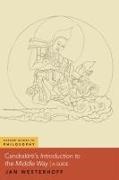Description
Product details
| Authors | Jan Westerhoff, Jan (Professor of Buddhist Philosophy Westerhoff, Westerhoff Jan |
| Publisher | Oxford University Press |
| Languages | English |
| Product format | Paperback / Softback |
| Released | 25.06.2023 |
| EAN | 9780197612347 |
| ISBN | 978-0-19-761234-7 |
| No. of pages | 296 |
| Series |
Oxford Guides to Philosophy OXFORD GUIDES TO PHILOSOPHY SERIES |
| Subjects |
Non-fiction book
> Philosophy, religion
> Other world religions
PHILOSOPHY / Mind & Body, RELIGION / Buddhism / General, Philosophy of Mind, PHILOSOPHY / Buddhist, Buddhism, East Asian and Indian philosophy, Oriental & Indian philosophy |
Customer reviews
No reviews have been written for this item yet. Write the first review and be helpful to other users when they decide on a purchase.
Write a review
Thumbs up or thumbs down? Write your own review.

